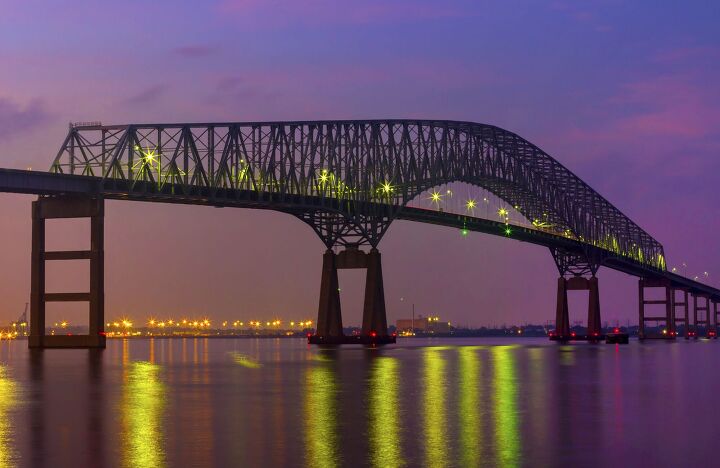
A cargo container ship exiting the Port of Baltimore collided with the Francis Scott Key Bridge early Tuesday morning. You’ve undoubtedly seen the footage by now, as well as the rampant speculation about what happened. As of now, nobody seems to know the full details of the incident but the ramifications should be relatively easy to predict. As a major shipping corridor for the United States, losing access means supply chain bottlenecks.
It simultaneously makes for a good excuse whenever the transport of goods is delayed or companies begin pitching higher rates for oceanic freight — something we saw take place in the wake of the pandemic.
The Port of Baltimore is responsible for moving all kinds of goods. But it’s most famous for passenger vehicles, semi trucks, and construction equipment. In fact, it’s typically the U.S. port that sees the largest number of cars and light trucks annually — at roughly 800,000 passenger vehicles per year.
However, losing the Francis Scott Key Bridge will effectively make the port useless until the area can be cleared of debris. Before collapsing, the bridge stood at the mouth of the port and required ships to pass beneath it to reach the docks. Until the necessary clean up has been concluded, no container ships will be able to use the port.
From Reuters:
Baltimore port’s private and public terminals handled 847,158 autos and light trucks in 2023, the most of any U.S. port. The port also handles farm and construction machinery, sugar, gypsum and coal, according to a Maryland government website.
The port handles imports and exports for major automakers including Nissan, Toyota, General Motors, Volvo, Jaguar Land Rover and the Volkswagen Group — including luxury models for Audi, Lamborghini and Bentley.
Volkswagen on Tuesday said its port operations in Baltimore were unaffected by a local bridge collapse due to the location of its facilities.
“We do not anticipate any impact on vessel operations but there may be trucking delays as traffic will be rerouted in the area,” the carmaker said in an e-mailed statement.
Meanwhile, logistics providers have been inundated with worried customers. The next few weeks will see numerous diversions to shipping routes and it’s likely to be several months before the port is even usable.
“Our first priority is engaging clients to make plans for containers that were originally routed to Baltimore that will be discharged at other ports on the Eastern Seaboard,” stated Paul Brashier, vice president of drayage and intermodal for ITS Logistics.
“These diverted volumes will impact the ports of New York/New Jersey, Norfolk and the Southeast and we have to prepare trucking and transload capacity to get that freight to its intended network.”
The container ship Dali that collided with the bridge was on its way out of the Port of Baltimore, en route to Colombo, Sri Lanka when it collided with one of the large pillars. The ship’s manifest stipulated that it was staffed by a 22-man crew from India. While there has been some speculation about a possible terror plot, strict terrorism seems unlikely due to the fact that the incident took place during the hours that the bridge would have been the least populated. Industrial or economic terrorism on behalf of another nation seems more likely. But there’s been no evidence to support either claim. At present, it appears to have been a terrible accident.
An investigation is underway but the only things they’ve been able to glean is what the public has already heard. Maryland Governor Wes Moore has said that the ship lost power shortly before the incident. There were also rumors of fire, however those appear to be unfounded.
Six individuals have been reported missing, though we don’t yet know who they are. Two individuals were pulled from the water. However, investigators using sonar have found that there are several vehicles located beneath the water. The Maryland Secretary of Transportation said some of those are assumed to have belonged to work crews that were present at the time of the crash.
The Singapore-flagged Dali had previously collided with a dock at Port of Antwerp in 2016. That incident was attributed to mistakes made by the master and pilot on board. Synergy Marine Group, which owns and manages the ship, confirmed the vessel hit a pillar of the bridge at about 1:30 on Tuesday morning, with every member of the crew accounted for.
President Joe Biden has reportedly said he plans to travel to Baltimore “as quickly as I can.” Statements were also made that he plans for the federal government to pick up the entire cost of rebuilding the Francis Scott Key Bridge.
“We’re going to rebuild that port together,” Biden from the White House, before departing for North Carolina to discuss the administration’s healthcare agenda as part of his reelection campaign.
If you live in the Midwest or Northeastern United States, there’s a good chance you’ll be impacted by the bridge going down. As previously mentioned, automobiles will be the primary cargo that’s to be affected. But coal, gasoline, construction materials, and a myriad of other items will likewise be impacted by the incident. Ships are already being rerouted to alternative ports. But it’ll be weeks before a comprehensive workaround is sorted out and any solution is likely to require the use of additional rail cars and trucking freight.
[Image: Alexander Briggs/Shutterstock]
Become a TTAC insider. Get the latest news, features, TTAC takes, and everything else that gets to the truth about cars first by subscribing to our newsletter.

